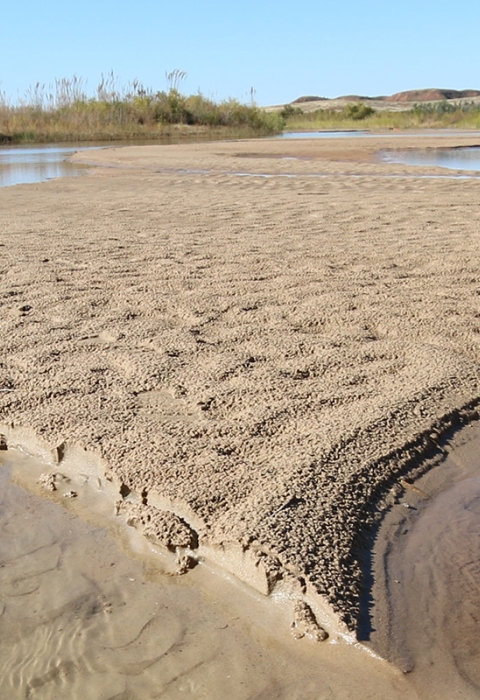About Us
This is the web site of the Oklahoma Ecological Services Field Office, located in Tulsa, Oklahoma. Below is some information about what we do.
Endangered Species and Conservation Planning Assistance
The Endangered Species program of our office is primarily responsible for reviewing public and private projects that may affect federally listed species. The Conservation Planning Assistance program (formally Federal Activities) reviews other federal programs such as U.S. Army Corps of Engineers wetland permits and Oklahoma Department of Transportation projects. These programs mainly work to implement the following Federal laws, amongst others:
- Endangered Species Act of 1973, 87 Stat. 884, as amended; 16 U.S.C. 1531 et seq.
- Clean Water Act of 1972, 33 U.S.C. 1344
- Fish and Wildlife Coordination Act of 1958, 48 Stat.401, as amended; 16 USC 661 et seq.
- Migratory Bird Treaty Act of 1918, 40 Stat. 755; 16 U.S.C. 703-712
- Bald and Golden Eagle Protection Act of 1940, 16 U.S.C. 668-668d
- National Environmental Policy Act of 1969, 83 Stat. 852; 42 U.S.C. 4321 et seq.
ENDANGERED SPECIES ACT (ESA) OVERVIEW: Section 7 Section 7
Section 7 Consultation
The Endangered Species Act (ESA) directs all Federal agencies to work to conserve endangered and threatened species and to use their authorities to further the purposes of the Act. Section 7 of the Act, called "Interagency Cooperation," is the mechanism by which Federal agencies ensure the actions they take, including those they fund or authorize, do not jeopardize the existence of any listed species.
Learn more about Section 7 (a)(1) requires Federal agencies, in consultation with the Service, to utilize their authorities in furtherance of the purposes of this Act by carrying out programs for the conservation of endangered and threatened species.
Section 7 (a)(2) requires Federal agencies to ensure that any action they authorize, fund, or carry out is not likely to jeopardize the continued existence of any federally listed threatened or endangered species or result in the destruction or adverse modification of designated critical habitat. In the event that a Federal agency determines that its action “may affect” a listed threatened or endangered species or designated critical habitat, the agency is required to consult with the Service regarding the degree of impact and measures available to avoid or minimize the adverse effects.
Section 9 makes it illegal for any person subject to the jurisdiction of the United States to “take” any federally listed endangered or threatened species of fish or wildlife without a special exemption. “Person” is defined under the ESA to include individuals, corporations, partnerships, trusts, associations, or any other private entity; local, state, and Federal agencies; or any other entity subject to the jurisdiction of the United States. Under the ESA, “take” means to harass, harm, pursue, hunt, shoot, wound, kill, trap, capture, collect, or to attempt to engage in any such conduct. Harm is further defined to include significant habitat modification or degradation that results in death or injury to listed species by significantly impairing essential behavior patterns such as breeding, feeding, or sheltering. Harass is defined as actions that create the likelihood of injury to listed species to such an extent as to significantly disrupt normal behavior patterns which include, but are not limited to, breeding, feeding, or sheltering.
Section 10 establishes an incidental take permit provision for private entities that includes the development of habitat conservation plans. This provision authorizes the Service, under some circumstances, to permit the taking of federally listed fish and wildlife if such taking is “incidental to, and not the purpose of carrying out otherwise lawful activities.” This process is also intended to be used to reduce conflicts between listed species and private development and to provide a framework that would encourage “creative partnerships” between the private sector and local, state, and Federal agencies in the interest of endangered and threatened species and habitat conservation. When approved by the Service, this regulatory procedure results in the issuance of a permit authorizing incidental take, provided such take is mitigated by appropriate conservation measures for habitat maintenance, enhancement, and protection, coincident with development.
It is important to distinguish between important habitat and Critical Habitat. Critical Habitat is federally designated and carries legal implications under the Endangered Species Act. Important habitat is habitat that a certain species needs for its survival and carries no legal implications.
The Service reviews projects that may adversely modify federally designated Critical Habitat, just as it reviews projects that may affect federally listed species. While both Federal and non-Federal actions that may affect listed species require consultation with the Service, only Federal actions that may adversely modify federally designated Critical Habitat requires consultation with the Service. However, it is important to clarify that any Federal nexus (Federal involvement) is sufficient to Federalize a proposed action. Some examples of actions with a Federal nexus are as follows:
- actions on Federal land
- actions that require a Federal permit (such as a wetland permit)
- actions that require a Federal license
- actions using Federal funds
Environmental Contaminants
The mission of the Oklahoma Ecological Service Contaminants program is to conserve, protect, and enhance fish, wildlife and their habitats by identifying, preventing, and restoring the effects of contaminants through collaboration with other Federal, Tribal, State, and local agencies as well as our partners in the academia, industry and the public. Please see the Contaminants link on the left for Natural Resources Damage Assessment and Restoration (NRDAR) documents and more information.
Partners for Fish & Wildlife Program
In 1990, the U.S. Fish and Wildlife Service's Partners for Fish and Wildlife Program (PFW) was initiated in Oklahoma. The Partners Program provides technical and financial assistance for restoration and enhancement of fish and wildlife habitat on private lands, in partnership with other state and federal agencies and non-governmental organizations. Please see the Partners link on the left for more information.
